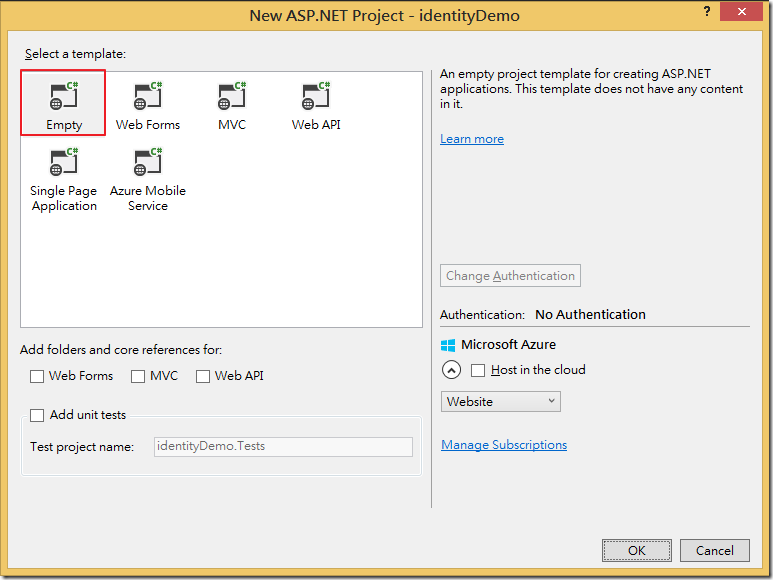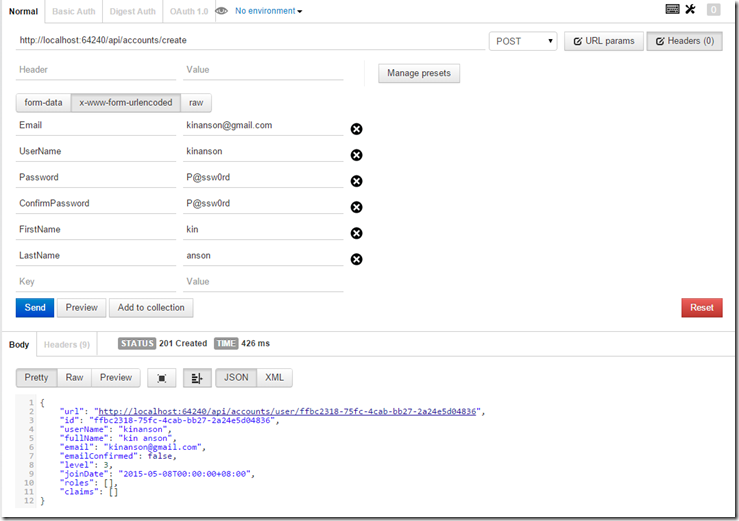WebApi-Identity AccountsManagement
前言
最近其實一直在研究identity的議題,希望也對此議題有興趣的人,可以有點幫助,因為我參考的文章是從無到有自己開發,所以我就邊看邊實作,成功了就順便記錄一下,廢話不多說,就先建立一個空白專案吧

接著打開nuget console輸入下面的指令,安裝起必要元件,紅框起來的都是要下載的




也可以直接用主控台的方式新增,我個人比較喜好這種方式,以下是所有需要下載的
Install-Package Microsoft.AspNet.Identity.Owin
Install-Package Microsoft.AspNet.Identity.EntityFramework
Install-Package Microsoft.Owin.Host.SystemWeb
Install-Package Microsoft.AspNet.WebApi.Owin
Install-Package Microsoft.Owin.Security.Oauth
Install-Package Microsoft.Owin.Cors
接著新增Infrastructure資料夾,然後新增如下類別,此類別是我們想擴增user的欄位
using Microsoft.AspNet.Identity.EntityFramework;
using System;
using System.Collections.Generic;
using System.ComponentModel.DataAnnotations;
using System.Linq;
using System.Web;
namespace identityDemo.Infrastructure
{
public class ApplicationUser : IdentityUser
{
[Required]
[MaxLength(100)]
public string FirstName { get; set; }
[Required]
[MaxLength(100)]
public string LastName { get; set; }
[Required]
public byte Level { get; set; }
[Required]
public DateTime JoinDate { get; set; }
}
}
在Infrastructure裡新增以下類別
using Microsoft.AspNet.Identity.EntityFramework;
using System;
using System.Collections.Generic;
using System.Linq;
using System.Web;
namespace identityDemo.Infrastructure
{
public class ApplicationDbContext : IdentityDbContext<ApplicationUser>
{
public ApplicationDbContext()
: base("DefaultConnection", throwIfV1Schema: false)
{
Configuration.ProxyCreationEnabled = false;
Configuration.LazyLoadingEnabled = false;
}
public static ApplicationDbContext Create()
{
return new ApplicationDbContext();
}
}
}
接著在web.config新增連線字串
<connectionStrings>
<add name="DefaultConnection" connectionString="Data Source=(localdb)\v11.0;Initial Catalog=Identitydb;Integrated Security=SSPI;" providerName="System.Data.SqlClient" />
</connectionStrings>
接著就是在nuget package打以下的指令,準備建立資料庫
enable-migrations
add-migration init
然後打開自動建立的Migrations>Configuration,新增一些預設資料
namespace identityDemo.Migrations
{
using identityDemo.Infrastructure;
using Microsoft.AspNet.Identity;
using Microsoft.AspNet.Identity.EntityFramework;
using System;
using System.Data.Entity;
using System.Data.Entity.Migrations;
using System.Linq;
internal sealed class Configuration : DbMigrationsConfiguration<identityDemo.Infrastructure.ApplicationDbContext>
{
public Configuration()
{
AutomaticMigrationsEnabled = false;
}
protected override void Seed(identityDemo.Infrastructure.ApplicationDbContext context)
{
// This method will be called after migrating to the latest version.
var manager = new UserManager<ApplicationUser>(new UserStore<ApplicationUser>(new ApplicationDbContext()));
var user = new ApplicationUser()
{
UserName = "SuperPowerUser",
Email = "taiseer.joudeh@mymail.com",
EmailConfirmed = true,
FirstName = "Taiseer",
LastName = "Joudeh",
Level = 1,
JoinDate = DateTime.Now.AddYears(-3)
};
manager.Create(user, "MySuperP@ssword!");
}
}
}
接著輸入下面指令,把db建立起來
update-database
UserManager提供的方法
| 方法 | 說明 |
| FindByIdAsync(id) | 用id找user類別 |
| Users | 得到全部user |
| FindByNameAsync(Username) | 用使用者名稱找user |
| CreateAsync(User, Password) | 新增使用者 |
| GenerateEmailConfirmationTokenAsync(Id) | 產生email token讓user驗証 |
| SendEmailAsync(Id, Subject, Body) | 寄送email去給user |
| ConfirmEmailAsync(Id, token) |
確認email使用者有收到token |
| ChangePasswordAsync(Id, OldPassword, NewPassword) |
改變密碼 |
| DeleteAsync(User) |
刪除user |
| IsInRole(Username, Rolename) |
確認user是此角色 |
| AddToRoleAsync(Username, RoleName) | 新增user去這個角色 |
| RemoveFromRoleAsync(Username, RoleName | 移除user從這個角色 |
接著在Infrastucture底下新增下面類別
using Microsoft.AspNet.Identity;
using Microsoft.AspNet.Identity.EntityFramework;
using Microsoft.AspNet.Identity.Owin;
using Microsoft.Owin;
using System;
using System.Collections.Generic;
using System.Linq;
using System.Web;
namespace identityDemo.Infrastructure
{
public class ApplicationUserManager : UserManager<ApplicationUser>
{
public ApplicationUserManager(IUserStore<ApplicationUser> store)
: base(store)
{
}
public static ApplicationUserManager Create(IdentityFactoryOptions<ApplicationUserManager> options, IOwinContext context)
{
var appDbContext = context.Get<ApplicationDbContext>();
var appUserManager = new ApplicationUserManager(new UserStore<ApplicationUser>(appDbContext));
return appUserManager;
}
}
}
新增一個App_Start,然後自行新增WebApiConfig.cs,新增如下程式碼
using Newtonsoft.Json.Serialization;
using System.Linq;
using System.Net.Http.Formatting;
using System.Web.Http;
public static class WebApiConfig
{
public static void Register(HttpConfiguration config)
{
config.MapHttpAttributeRoutes();
config.Routes.MapHttpRoute(
"DefaultApi",
"api/{controller}/{id}",
new { id = RouteParameter.Optional });
var jsonFormatter = config.Formatters.OfType<JsonMediaTypeFormatter>().First();
jsonFormatter.SerializerSettings.ContractResolver = new CamelCasePropertyNamesContractResolver();
}
}
接著在根目錄下,直接新增一支Startup.cs,在web api要求之前,皆會先從此開始
using identityDemo.App_Start;
using identityDemo.Infrastructure;
using Newtonsoft.Json.Serialization;
using Owin;
using System;
using System.Collections.Generic;
using System.Linq;
using System.Net.Http.Formatting;
using System.Web;
using System.Web.Http;
namespace identityDemo
{
public class Startup
{
public void Configuration(IAppBuilder app)
{
HttpConfiguration httpConfig = new HttpConfiguration();
ConfigureOAuthTokenGeneration(app);
WebApiConfig.Register(httpConfig);
app.UseCors(Microsoft.Owin.Cors.CorsOptions.AllowAll);
app.UseWebApi(httpConfig);
}
private void ConfigureOAuthTokenGeneration(IAppBuilder app)
{
// 配置此db context 和 user manager去使用single instance per request
app.CreatePerOwinContext(ApplicationDbContext.Create);
app.CreatePerOwinContext<ApplicationUserManager>(ApplicationUserManager.Create);
// Plugin the OAuth Token產生和消耗將在此
}
}
}
接著新增一個Models的資料夾,先新增一支專門回應給前端的類別
using identityDemo.Infrastructure;
using System;
using System.Collections.Generic;
using System.Linq;
using System.Net.Http;
using System.Web;
using System.Web.Http.Routing;
namespace identityDemo.Models
{
public class ModelFactory
{
private UrlHelper _UrlHelper;
private ApplicationUserManager _AppUserManager;
public ModelFactory(HttpRequestMessage request, ApplicationUserManager appUserManager)
{
_UrlHelper = new UrlHelper(request);
_AppUserManager = appUserManager;
}
public UserReturnModel Create(ApplicationUser appUser)
{
return new UserReturnModel
{
Url = _UrlHelper.Link("GetUserById", new { id = appUser.Id }),
Id = appUser.Id,
UserName = appUser.UserName,
FullName = string.Format("{0} {1}", appUser.FirstName, appUser.LastName),
Email = appUser.Email,
EmailConfirmed = appUser.EmailConfirmed,
Level = appUser.Level,
JoinDate = appUser.JoinDate,
Roles = _AppUserManager.GetRolesAsync(appUser.Id).Result,
Claims = _AppUserManager.GetClaimsAsync(appUser.Id).Result
};
}
}
public class UserReturnModel
{
public string Url { get; set; }
public string Id { get; set; }
public string UserName { get; set; }
public string FullName { get; set; }
public string Email { get; set; }
public bool EmailConfirmed { get; set; }
public int Level { get; set; }
public DateTime JoinDate { get; set; }
public IList<string> Roles { get; set; }
public IList<System.Security.Claims.Claim> Claims { get; set; }
}
}
WebApi部份
先新增一個Controllers的資料夾,然後新增一個父類別,此後新增的web api都會繼承此父類別
using identityDemo.Infrastructure;
using identityDemo.Models;
using Microsoft.AspNet.Identity;
using System;
using System.Collections.Generic;
using System.Linq;
using System.Web;
using System.Web.Http;
using System.Net.Http;
using Microsoft.AspNet.Identity.Owin;
namespace identityDemo.Controllers
{
public class BaseApiController : ApiController
{
private ModelFactory _modelFactory;
private ApplicationUserManager _AppUserManager = null;
protected ApplicationUserManager AppUserManager
{
get
{
return _AppUserManager ?? Request.GetOwinContext().GetUserManager<ApplicationUserManager>();
}
}
public BaseApiController()
{
}
protected ModelFactory TheModelFactory
{
get
{
if (_modelFactory == null)
{
_modelFactory = new ModelFactory(this.Request, this.AppUserManager);
}
return _modelFactory;
}
}
protected IHttpActionResult GetErrorResult(IdentityResult result)
{
if (result == null)
{
return InternalServerError();
}
if (!result.Succeeded)
{
if (result.Errors != null)
{
foreach (string error in result.Errors)
{
ModelState.AddModelError("", error);
}
}
if (ModelState.IsValid)
{
return BadRequest();
}
return BadRequest(ModelState);
}
return null;
}
}
}
再新增一個專門管理Account的web api
using System;
using System.Collections.Generic;
using System.Linq;
using System.Threading.Tasks;
using System.Web;
using System.Web.Http;
namespace identityDemo.Controllers
{
[RoutePrefix("api/accounts")]
public class AccountsController : BaseApiController
{
[Route("users")]
public IHttpActionResult GetUsers()
{
return Ok(this.AppUserManager.Users.ToList().Select(u => this.TheModelFactory.Create(u)));
}
[Route("user/{id:guid}", Name = "GetUserById")]
public async Task<IHttpActionResult> GetUser(string Id)
{
var user = await this.AppUserManager.FindByIdAsync(Id);
if (user != null)
{
return Ok(this.TheModelFactory.Create(user));
}
return NotFound();
}
[Route("user/{username}")]
public async Task<IHttpActionResult> GetUserByName(string username)
{
var user = await this.AppUserManager.FindByNameAsync(username);
if (user != null)
{
return Ok(this.TheModelFactory.Create(user));
}
return NotFound();
}
}
}
接著在Models底下新增類別,這類別是要在新增使用者所傳進的內容
using System;
using System.Collections.Generic;
using System.ComponentModel.DataAnnotations;
using System.Linq;
using System.Web;
namespace identityDemo.Models
{
public class CreateUserBindingModel
{
[Required]
[EmailAddress]
[Display(Name = "Email")]
public string Email { get; set; }
[Required]
[Display(Name = "Username")]
public string Username { get; set; }
[Required]
[Display(Name = "First Name")]
public string FirstName { get; set; }
[Required]
[Display(Name = "Last Name")]
public string LastName { get; set; }
[Display(Name = "Role Name")]
public string RoleName { get; set; }
[Required]
[StringLength(100, ErrorMessage = "The {0} must be at least {2} characters long.", MinimumLength = 6)]
[DataType(DataType.Password)]
[Display(Name = "Password")]
public string Password { get; set; }
[Required]
[DataType(DataType.Password)]
[Display(Name = "Confirm password")]
[Compare("Password", ErrorMessage = "The password and confirmation password do not match.")]
public string ConfirmPassword { get; set; }
}
}
接著在已建立的AccountController.cs新增下面程式碼
[Route("create")]
public async Task<IHttpActionResult> CreateUser(CreateUserBindingModel createUserModel)
{
if (!ModelState.IsValid)
{
return BadRequest(ModelState);
}
var user = new ApplicationUser()
{
UserName = createUserModel.Username,
Email = createUserModel.Email,
FirstName = createUserModel.FirstName,
LastName = createUserModel.LastName,
Level = 3,
JoinDate = DateTime.Now.Date,
};
IdentityResult addUserResult = await this.AppUserManager.CreateAsync(user, createUserModel.Password);
if (!addUserResult.Succeeded)
{
return GetErrorResult(addUserResult);
}
Uri locationHeader = new Uri(Url.Link("GetUserById", new { id = user.Id }));
return Created(locationHeader, TheModelFactory.Create(user));
}
接著我還是用PostMan來發一個create新增一位使用者,如下圖

以上再請大家多多指教。
